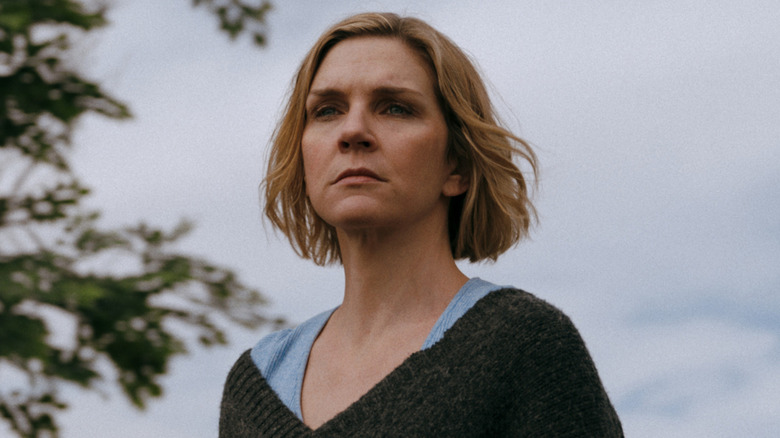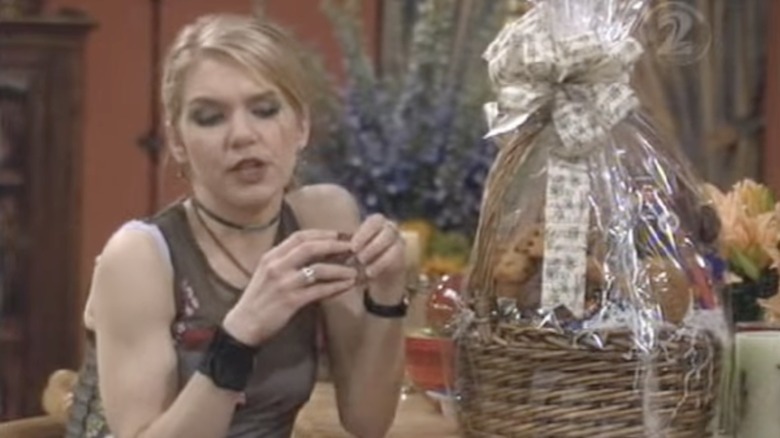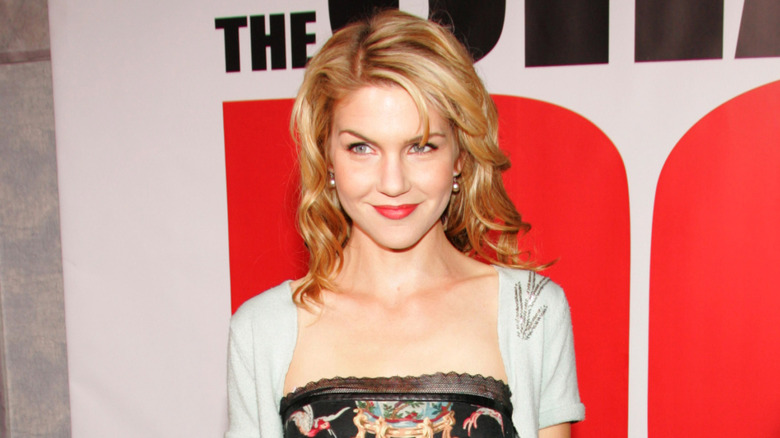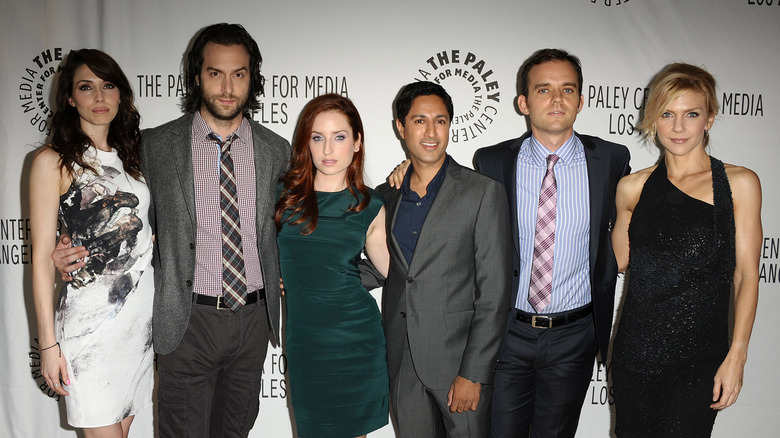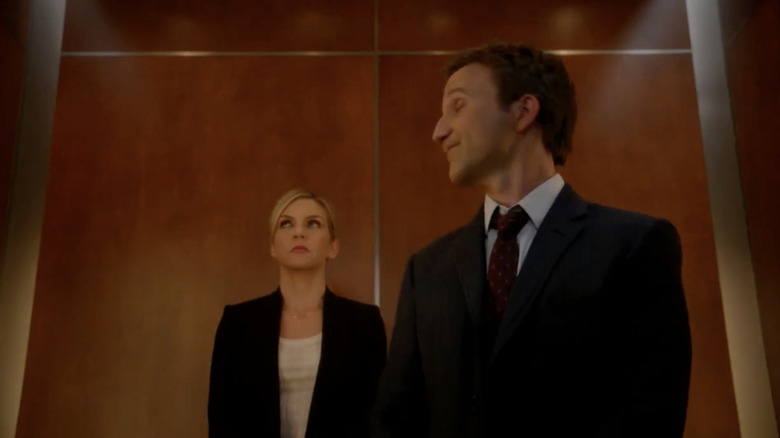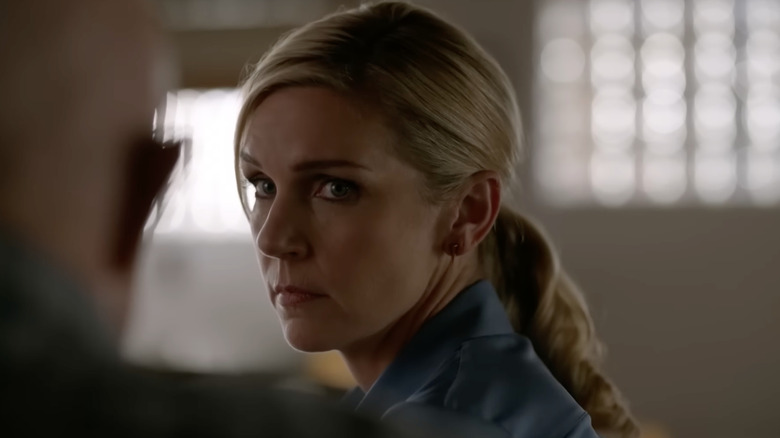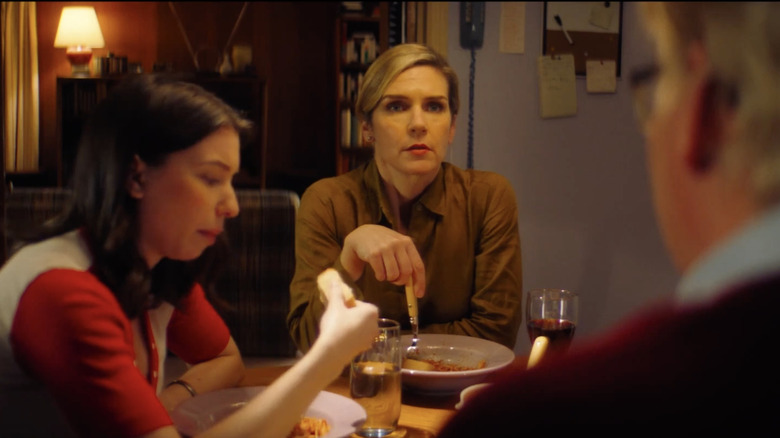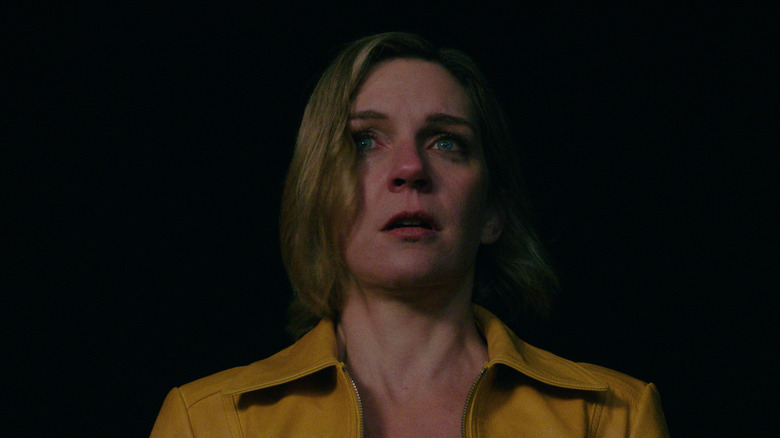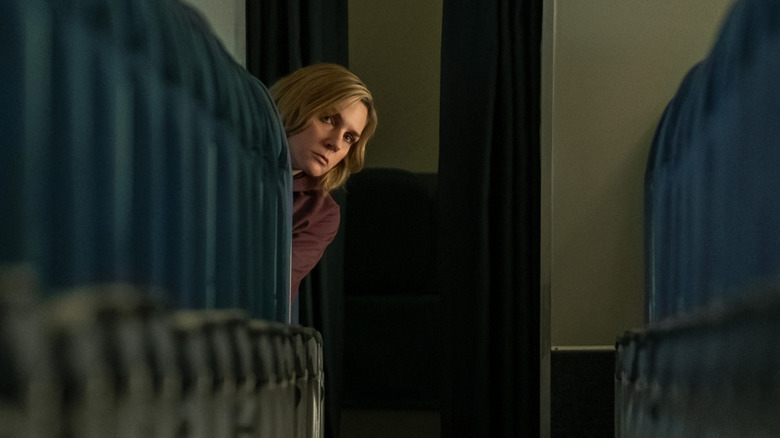Why Carol From Pluribus Looks So Familiar
Writer and producer Vince Gilligan is responsible for two of television's most critically acclaimed series in recent memory: "Breaking Bad" and its sequel, "Better Call Saul." While the former focused on a high school chemistry teacher Walter White's slow evolution into murderous meth-making drug kingpin, the latter focused on his lawyer, Saul Goodman, who, for reasons explained in the series, is actually named Jimmy McGill, and breaks bad in his own way to become his garishly attired alter ego.
Ever since "Better Call Saul" ended its run in 2022 — racking up 53 Emmy nominations (but, criminally, zero wins) along the way — fans have been wondering what Gilligan's next project will be. Over time, info started dribbling out about a mysterious series for Apple TV called "Pluribus," its plot kept top secret for years while anticipation built, hitting a fever pitch in the months before its premiere on streaming service Apple TV thanks to a fiendishly cryptic marketing campaign.
When "Pluribus" finally made its debut, it all became clear. Melding comedy, drama, sci-fi and other elements, the plot of the pilot episode could have easily been an episode of "The Twilight Zone." In a nutshell: a mysterious virus infects nearly all of humanity but, instead of turning everyone into zombies, makes the infected annoyingly cheery. Only 12 people on the entire planet have managed to remain uncontaminated, one of whom is cynical romance novelist Carol Sturka, played by Rhea Seehorn. As this new series is showered in accolades as viewer interest builds, read further to find out why Carol from "Pluribus" looks so familiar.
Her first big acting roles were in a video game and a hit cop show
After graduating college with a degree in visual arts and drama, Rhea Seehorn decided to focus on the latter by performing in theatrical productions in the Washington, D.C. area, where she was living at the time. Her first non-theater role was in a video game, playing a sorceress in the tutorial for the 1997 PC game "Magic the Gathering." "It was super low-budget," she recalled in an interview with ComingSoon.net, revealing that the "gladiator-style sorcery boots" she wore were actually white tube socks adorned with electrical tape. She didn't make much money, but saw the gig as an opportunity to gain on-camera experience.
That same year, Seehorn made her television debut in an episode of "Homicide: Life on the Street." Her time onscreen was brief — less than a minute — while playing a woman being questioned about a murder victim. As she told Rolling Stone, that was one of the few times that going on an audition actually resulted in getting a job in those early days. "By then I was a 25-year-old blonde, so I would get sent in for the ingénue, but I would go at it as a character actor," she recalled. "I can't just play the guy's girlfriend. If the most interesting thing about me is my boyfriend, I'm not going to get the part, because I would add all this subtext of like, 'No, no, no. There has to be something going on with her. Was she abused? Why is she just standing there?' I didn't get parts for a while because of that."
Rhea Seehorn starred in a couple of failed TV sitcoms
Rhea Seehorn had been working in theater for more than a decade when she made her Broadway debut, cast as an understudy in the 2001 Neil Simon comedy "45 Seconds from Broadway." Unlike most of Simon's other plays, however, this one was not a hit; "45 Seconds from Broadway" closed after just 73 performances. Following that, she was cast in "I'm With Her," an ABC sitcom about a high school teacher who falls in love with a movie star. In the series, which was canceled after a single season, Seehorn played Cheri Baldzikowski, the movie star's sarcastic, wisecracking sister. "When that show was over, I had a bunch of auditions — and they were all for sitcoms," she told Rolling Stone. "I was like, well, that's cool. Then I was fortunate enough to get another sitcom. But I started to realize, 'I'm only being called in for sitcoms.'"
In those sitcoms, "Head Cases" in 2005, and "The Singles Table" in 2007, Seehorn played a variation of the same character, the caustic, smart-mouthed best friend. At first, Seehorn didn't mind being pigeonholed, as long as it meant she'd have a job. "I got typecast as something that I was very proud of, which was this very wry, sarcastic, knowing [woman]," she said in a different interview with Rolling Stone
As time passed and she continued to be cast as what was essentially the same sitcom character, Seehorn grew restless. "There is a part of me that didn't want to be pigeonholed," she said. She set her sights on more ambitious roles in edgier shows, but experienced pushback from casting directors. "The feedback would be like, 'Well, they just know her as a sitcom actress,'" she said.
She was a guest star on several hit TV shows
In the late 2000s, Rhea Seehorn began pursuing roles outside of the sitcom prison she'd somehow found herself trapped within. That included "Eva Adams," a 2009 television pilot that wasn't picked up, about a womanizing, chauvinist guy who is magically transformed into a woman. She also had a small role in "The Shaggy Dog," Disney's 2006 remake starring Tim Allen.
After that, she guest-starred in various series, including advertising agency dramedy "Trust Me," sci-fi series "Dollhouse," espionage thriller "Burn Notice," and legal drama "The Closer." These roles may not have been career-making, but they served the purpose of showing casting directors that Seehorn could shine in projects beyond sitcoms. "It was always: 'Not weird enough looking to play the sidekick friend, but not attractive enough to be your leading lady,'" Seehorn told Rolling Stone. "All the time. I'd hear, 'We don't know what to do with you.'"
However, fate would intervene to put that particular dream on hold, at least for a while. When an offer came to become a series regular in a high-profile network sitcom, Seehorn could not refuse.
Rhea Seehorn was a series regular on sitcom Whitney
In 2011, Rhea Seehorn was cast in "Whitney," an NBC sitcom starring standup comic Whitney Cummings. Seehorn played Roxanne, the best friend of Cummings' character.
Interviewed by Press Pass LA after completing work on the second season, Seehorn gushed about how much she enjoyed working on "Whitney." "I love, love, loved the script and was just in love with the character of Roxanne," she said. "What appealed to me even more was, they're writing fully three-dimensional people ... it's not a bunch of insults, and one liners."
At the time of the interview, the network had yet to decide whether "Whitney" would return for a third season. "I'd be extremely saddened if I didn't get to continue developing that character and developing that show," she said, sharing her hopes that the series would be renewed. In the end, that didn't happen, with "Whitney" ending its run after just two seasons. And while that had been the longest period of time that Seehorn had ever worked on a series, its cancellation opened the door to opportunities that would ultimately pave the way for far bigger and better things.
She had a recurring role on Franklin and Bash
After "Whitney" ended, Rhea Seehorn didn't remain unemployed for long. Shortly after the series' cancellation, she landed a recurring role in legal drama "Franklin & Bash" as district attorney Ellen Swatello. She would go on to play the character, off and on, between 2011 and 2013. "I love 'Franklin & Bash.' I love that show!" Seehorn declared in an interview with Collider, recalling her character's terse way of communicating. "I feel like Ellen was very aware of her zingers," she added.
During this same period, Seehorn also managed to squeeze in some TV guest spots. Those included lending her voice to a 2013 episode of "Family Guy," along with appearing in two episodes of "House of Lies."
As it turned out, Ellen Swatello would not be the last lawyer that Seehorn would play. Just around the corner was another character, also an attorney; this role, however, would completely change her life.
Her big break came when she was cast as Kim Wexler in Better Call Saul
After critically acclaimed TV drama "Breaking Bad" ended its run, the series' creator, Vince Gilligan, launched a spinoff built around sleazy lawyer Saul Goodman (comedy writer and actor Bob Odenkirk), who'd help Walter White ("Breaking Bad" star and "Malcolm in the Middle" cast alum Bryan Cranston) launder money. Cast in the role of the title character's girlfriend/fellow lawyer, Kim Wexler, was Rhea Seehorn.
Like its predecessor, "Better Call Saul" was received with critical acclaim. As the series progressed, Kim evolved into a far more nuanced and complex character than the woman viewers met in the first episode. Meanwhile, Seehorn was praised for her performance — even receiving two Emmy nominations. "She just brings so much depth, and there's so much thought and so much intelligence to every moment that she plays," "Better Call Saul" co-creator Peter Gould told Rolling Stone. "She's just fascinating to watch. You want to know what's going on between those ears."
When "Saul" ended its run in 2022 after six seasons and 61 episodes, Kim had evolved exponentially, as had the actor who brought her to life. "It's the best part I've ever played, and I will miss that experience, and I will miss all the people on it," she told the magazine while ruminating about the series' upcoming end.
Rhea Seehorn displayed her comedy chops in Veep
In the midst of her six seasons on "Better Call Saul," Rhea Seehorn availed herself of other acting opportunities that bubbled up. That included TV guest spots in various shows, including "Shut Eye," "Law & Order: Special Victims Unit," and the revival of "Roseanne" — prior to the show's cancellation due to a highly problematic tweet from the sitcom's controversial namesake star, Roseanne Barr. She also appeared in "The Act" — a miniseries about the twisted true tale of Gypsy Rose Blanchard — and starred in her own standalone episode of "The Twilight Zone."
She was also cast in a recurring role on acclaimed HBO comedy "Veep," in which former "Seinfeld" star Julia Louis-Dreyfus played the fictional vice president of the United States. Seehorn appeared in five 2019 episodes as Michelle York, chief of staff to Louis-Dreyfus' Selina Meyer after she wound up as president. For Seehorn, the experience of acting in two shows concurrently was a treat, despite the workload. "'Veep' does bounce back and forth between the comedy of the tragedy and the tragedy of the comedy — it tips towards comedy and ['Saul'] is tipped towards drama, but it is fun getting the extreme pleasure of being on two shows," she told Vulture.
She co-starred with comedian Jim Gaffigan in indie film Linoleum
Following "Better Call Saul," Rhea Seehorn's next project, the indie film "Linoleum," was released. As her fans had come to expect, this was no run-of-the-mill movie, but the quirky tale of the host of a TV science show for kids (played by comedian-turned-dramatic actor Jim Gaffigan) who, after a satellite crashes in his backyard, decides to fulfill his lifelong quest to become an astronaut by rebuilding the satellite into a rocket that will carry him to space. Meanwhile, he begins experiencing weird phenomena and becomes increasingly untethered from reality, causing his relationship with his wife (Seehorn) to become strained.
According to Seehorn — who'd shot the film during the hiatus between the fifth and sixth seasons of "Saul" — her "Linoleum" character, Erin, is practical and pragmatic, while her husband is a head-in-the-clouds dreamer, a dynamic that establishes conflict between the spouses. "And I think the frustration of that resonates with a lot of people," she noted during a 2023 interview with The Hollywood Reporter. "We also talked about the love and the burden that goes into being assigned a caretaker role, which I think also resonates with a lot of people."
Better Call Saul creator Vince Gilligan wrote Pluribus just for Rhea Seehorn
After "Better Call Saul" ended, series creator Vince Gilligan was not done working with Rhea Seehorn. Having witnessed her effortless ability to shift between comedy and drama, Gilligan decided that his next television project would be one written specifically with Seehorn in mind. That was how she came to star in "Pluribus," in which "the most miserable person on Earth must save the world from happiness," per the series' synopsis.
For Seehorn, collaborating with Gilligan once again was an utter no-brainer, especially when she read the first script and realized what a unique and complicated character he'd created in misanthropic romance novelist Carol Sturka. "He just wrote a complex human being that happens to be a woman," Seehorn said in a 2025 interview with The Hollywood Reporter, discussing the perpetual anger her character experiences in the face of the relentless cheeriness she encounters from the infected. "However, I'm coming to it as a woman," she added, "so the fact that her anger is seen as a source of power — but also something that people are afraid of due its dire consequences — really resonated with me."
Meanwhile, because Gilligan was insistent that "Pluribus" remain top secret, Seehorn had to keep her lips sealed for three full years until the series premiere was finally unveiled in November 2025. As a result, viewers will experience the story as it unfolds, episode by episode — just as Seehorn did, script by script. "It was bananas," she said of the first script in a different interview with The Hollywood Reporter. "I got episode two and I was like ... this is just gonna keep getting weirder and weirder ... This would be a show I'd want to watch in a heartbeat. I can't believe I get to do it."
Pluribus brought Rhea Seehorn some of the best reviews of her career
So certain was Apple TV that Vince Gilligan's "Pluribus" would be a hit with viewers, the series was renewed for a second season before a single episode streamed. For star Rhea Seehorn, Carol Sturka represented not only her first-ever starring role in a TV series, but also brought her the kind of reviews any actor could only dream of. "The entire weight of the show rests on Seehorn's shoulders, and she's proving herself more than capable of carrying it," read a review from Toronto Film School. "Her performance as Carol is enormous, in quality and quantity," declared The New York Times. Meanwhile, RogerEbert.com lauded her presence, writing that "Seehorn undeniably commands the screen"; NPR praised her "extraordinary work."
Despite the series' far-fetched "Twilight Zone"-style plot — in which a weird virus has transformed nearly everyone on the planet into ridiculously happy human bobbleheads — Seehorn insisted on keeping Carol grounded in reality. "I tried to always look at her as a reluctant normal hero, not a superhuman, who's been thrust into this incomprehensible world and is taking it step by step," she explained to The Hollywood Reporter. "She's trying to do the best she can in a very confusing situation, and I kept hoping that that would be why somebody would sympathize with her."
That said, Seehorn is also cognizant that the material she's been given to work with comes from one of the finest television writers in the medium's history. "I won the lottery with Vince," she told The Hollywood Reporter. "He'll just write wherever he wants the story to go, and I couldn't be more thankful for the challenges he gives me and that I try to rise to."
